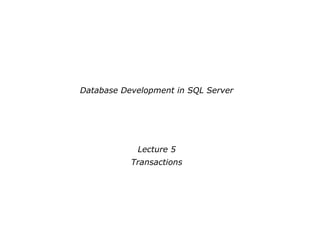
SQL Transactions and Isolation Levels Explained
- 1. Database Development in SQL Server Lecture 5 Transactions
- 2. Transactions A transaction is a sequence of database operations with the following properties (ACID): ● Atomic: Operations of a transaction are executed all-or-nothing, and are never left “half-done” ● Consistency:Assume all database constraints are satisfied at the start of a transaction, they should remain satisfied at the end of the transaction ● Isolation: Transactions must behave as if they were executed in complete isolation from each other ● Durability: If the DBMS crashes after a transaction commits, all effects of the transaction must remain in the database when DBMS comes back up
- 3. Behaviour ● A transaction is automatically started when a user executes an SQL statement ● Subsequent statements in the same session are executed as part of this transaction – Statements see changes made by earlier ones in the same transaction – Statements in other concurrently running transactions do not ● COMMIT command commits the transaction – Its effects are made final and visible to subsequent transactions ● ROLLBACK command aborts the transaction – Its effects are undone
- 4. Fine prints ● Schema operations (e.g., CREATE TABLE) implicitly commit the current transaction – Because it is often difficult to undo a schema operation ● Many DBMS support an AUTOCOMMIT feature, which automatically commits every single statement – You can it on/off through the API (e.g., JDBC)
- 5. Atomicity ● Partial effects of a transaction must be undone when – User explicitly aborts the transaction using ROLLBACK ● E.g., application asks for user confirmation in the last step and issues COMMIT or ROLLBACK depending on the response – The DBMS crashes before a transaction commits ● Partial effects of a modification statement must be undone when any constraint is violated – However, only this statement is rolled back; the transaction continues ● How is atomicity achieved? – Logging (to support undo)
- 6. Durability ● Effects of committed transactions must survive DBMS crashes ● How is durability achieved? – Forcing all changes to disk at the end of every transaction? ● Too expensive: DBMS manipulates data in memory – Logging (to support redo)
- 7. Consistency ● Consistency of the database is guaranteed by constraints and triggers declared in the database and/or transactions themselves – Whenever inconsistency arises, abort the statement or transaction, or (with deferred constraint checking or application-enforced constraints) fix the inconsistency within the transaction
- 8. Isolation ● Transactions must appear to be executed in a serial schedule (with no interleaving operations) ● For performance, DBMS executes transactions using a serializable schedule – In this schedule, operations from different transactions can interleave and execute concurrently – But the schedule is guaranteed to produce the same effects as a serial schedule ● How is isolation achieved? – Locking, multi-version concurrency control, etc.
- 9. SQL isolation levels ● Strongest isolation level: SERIALIZABLE – Complete isolation – SQL default (not always) ● Weaker isolation levels: REPEATABLE READ, READ COMMITTED, READ UNCOMMITTED – Increase performance by eliminating overhead and allowing higher degrees of concurrency – Trade-off: sometimes you get the “wrong” answer
- 10. READ UNCOMMITTED ● Can read “dirty” data – A data item is dirty if it is written by an uncommitted transaction ● Problem: What if the transaction that wrote the dirty data eventually aborts? ● Example: wrong average – -- T1: -- T2: UPDATE Student SET GPA = 3.0 WHERE SID = 142; SELECT AVG(GPA) FROM Student; ROLLBACK; COMMIT;
- 11. READ COMMITTED ● No dirty reads but non-repeatable reads possible – Reading the same data item twice can produce different results ● Example: different averages – -- T1: -- T2: SELECT AVG(GPA) FROM Student; UPDATE Student SET GPA = 3.0 WHERE SID = 142; COMMIT; SELECT AVG(GPA) FROM Student; COMMIT;
- 12. REPEATABLE READ ● Reads are repeatable, but may see phantoms ● Example: different average (still!) – -- T1: -- T2: SELECT AVG(GPA) FROM Student; INSERT INTO Student VALUES(789, ‘Nelson’, 10, 1.0); COMMIT; SELECT AVG(GPA) FROM Student; COMMIT;
- 13. Summary of SQL isolation levels Syntax: At the beginning of a transaction SET TRANSACTION ISOLATION LEVEL isolation_level; Dirty reads Non-repeatable reads Phantoms READ UNCOMMITTED READ COMMITTED Impossible REPEATABLE READ Impossible Impossible SERIALIZABLE Impossible Impossible Impossible
- 14. ANSI isolation levels are lock-based ● READ UNCOMMITTED – Short-duration locks: lock, access, release immediately ● READ COMMITTED – Long-duration write lock: do not release write locks until commit ● REPEATABLE READ – Long-duration locks on all data items accessed ● SERIALIZABLE – Lock ranges to prevent insertion as well
- 15. An isolation level not based on locks Snapshot isolation ● Based on multiversion concurrency control ● Available in Oracle, PostgreSQL, MS SQL Server, etc. ● How it works – Transaction X performs its operations on a private snapshot of the database taken at the start of X – X can commit only if it does not write any data that has been also written by a transaction committed after the start of X ● Avoids all ANSI anomalies ● But is NOT equivalent to SERIALIZABLE because of write skew anomaly
- 16. Bottom line ● Group reads and dependent writes into a transaction in your applications – E.g., enrolling a class, booking a ticket ● Anything less than SERIALABLE is potentially very dangerous – Use only when performance is critical – READ ONLY makes weaker isolation levels a bit safer
